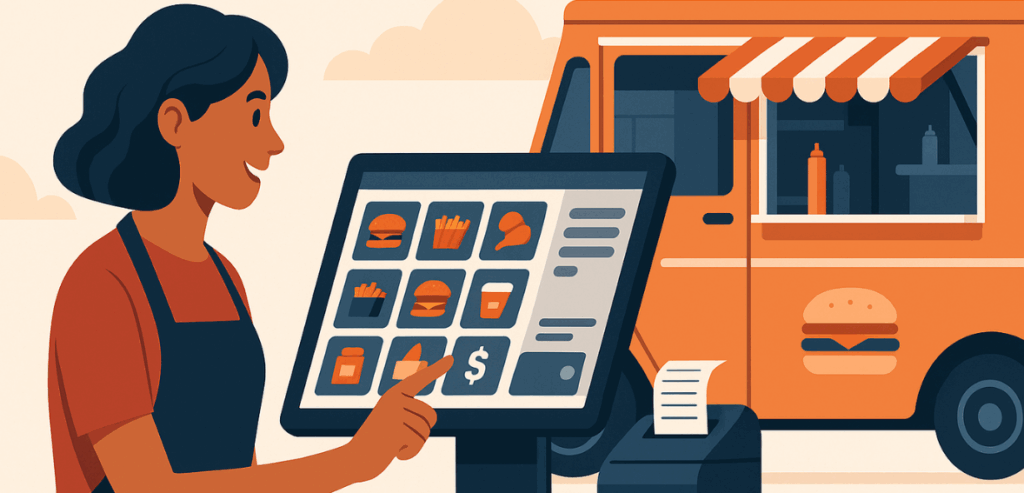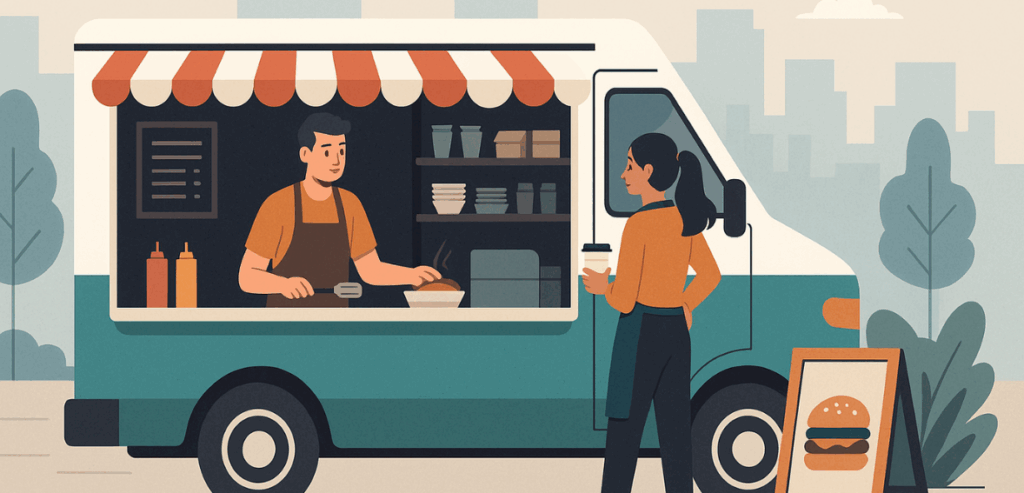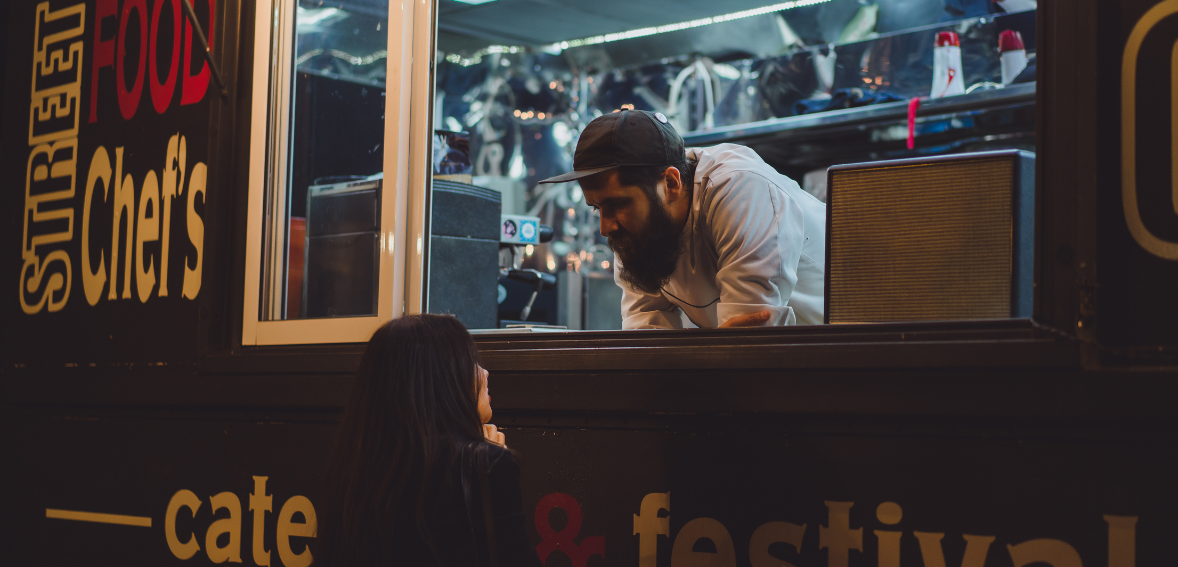Mobile food trucks are changing the way people experience food. They move easily, require less initial investment, and offer more room for innovation. It’s a smart move to launch a food truck whether one is an imaginative chef or an entrepreneur with a delicious new concept. In contrast to a traditional restaurant, a food truck has lower risks. You can bring your food directly to consumers–festivals, offices, college campuses, and so on. For novice food-business operators, this kind of flexibility makes the industry even more attractive as a career choice. However, setting up a food truck business is not as easy as buying a truck and turning on the gas.
This requires licenses, permits, the appropriate equipment for your profession, planning of menu items and staff employees, installation of POS systems and much more. Are you planning to run a food truck business? Then in this post, we will be highlighting some of the essential steps to take to start your business.
Starting Your Food Truck Business – Important Things to Consider
1. Research and Planning Your Food Truck Business

A. Find Your Niche and Concept
Start by identifying your product. What are you producing? Gourmet hamburgers? Tacos without meat (vegetarian)? Choice of international snacks? The options are endless. Your concept should reflect your passion and meet a market need. A focused, memorable theme attracts attention and keeps operations efficient.
B. Market Research
Go to local food trucks and see what is trending and what is missing. Locate popular locations for food trucks or if they operate regularly. Look for inconveniences, or consumer desires that aren’t being met–long lines, poor service–so you can profit from them.
C. Budgeting and Financial Plan
The capital outlay for a complete setup can run from $50,000 to over $150,000, depending on the truck, kitchen and other equipment, branding and add-ons like a POS system. Budget for:
- Truck purchase or lease
- Kitchen build-out and equipment
- Business licenses and permits
- Branding and marketing
- Initial inventory and staff pay
- Technology (POS, digital menu displays, etc.)
You should have an idea of what a food truck startup costs, that includes the breakdown of the costs of the listed items. Plan for six months of operating costs as a financial cushion.
2. Legal Requirements and Permits
Operating a food truck legally requires compliance with laws. While each city or state can have slightly different requirements, there are basics that are pretty universal.
A. Business License and Registration
Start by registering your business. Choose a structure—sole proprietorship, partnership, LLC, or corporation. Most food truck owners go with an LLC for liability protection.
Next, apply for a business license through your local government. This legalizes your operations and gives you a tax ID. Some cities also require a mobile food vendor license.
B. Health and Safety Permits
Health inspection and sanitation codes must be satisfied and passed in order for your food truck to be used. This usually means:
- Food Handler Permits for you and your crew
- Hand Wash sinks and clean cooking
- Safe storage, hygiene and pest control
Before you start, you must get permission from your local health department.
C. Location Permits and Zoning
Each and every city has its own rules regarding the places and timing for food trucks parked on road. You may need:
- Street vending permits
- Parking zone clearance
- Commissary agreements (a licensed facility for storage/prep)
- Fire inspection certificates
Zoning laws are different from neighborhood to neighborhood so be sure to double check before parking.
3. Choosing and Customizing Your Food Truck

Your truck is more than transportation—it’s your kitchen, store front, and brand on wheels. Choosing the right one is crucial.
A. Buying vs. Leasing
Buying a food truck is a big investment but grants full control. Everything is possible to personalize-layout, equipment, brand image .Leasing is cheaper upfront and ideal for testing the waters. But you may run into limits on customization or end up with out-of-date equipment. Choose the right one for your budget and long-term goals.
B. Truck Equipment Essentials
Also consider your menu when you are deciding where to put your stove. Common equipment includes: Griddle or flat-top grill Deep fryer Refrigeration and freezing units Food warmers Sinks with hot waterEven if not required by city or county codes, it is a good idea to install a hood for ventilation.
In case of fire, you may also need to have hoods over the stove and dishwasher. Non-slip floors are a useful addition. Install a ventilation hood, fire suppression system, and non-slip flooring. These are often required by health and fire codes. Make sure everything is powered properly—trucks usually run on propane, generators, or batteries.
C. Branding and Design
Your truck’s look draws customers before the food does. Wrap your truck in vinyl with your business name, slogan, and social media handles. Visibility drives traffic.
4. Setting Up Operations
When your truck is ready, it’s just time to start thinking about the operations. Service model, menu, and suppliers will also determine how well your business does right from the start.
A. Staffing
You don’t need a large team. Most food trucks operate with 2–4 staff:
- One or two cooks
- One cashier/server
- One floater or prep hand
Hire employees who can multitask in tight spaces. Train them in health and fire safety, speed, and customer service.
B. Menu Planning
Keep it short and sweet. A limited menu ensures fast preparation, less waste, and customers can choose quickly. Focus on high-margin items that are easy to prepare and serve. Rotate specials to keep regulars excited. Test your recipes for speed and consistency .Use your POS system to track best sellers and remove slow movers.
C. Supplier and Inventory Setup
Partner with local suppliers for fresh, consistent ingredients. Negotiate bulk deals where possible. In addition, made it a must to purchase all products from these vendors off the wholesale market (bulk orders).
Create a system like checklists to grab your day-to-day inventory in time. Don’t over-order perishable stuff. It erodes profit margins.
Make sure suppliers are on a regular delivery schedule. During busy hours, you don’t want to run out of items.
More efficient operations lead to smoother service and fatter profits.
5. Adding a POS System to Streamline Operations

A POS (Point of Sale) system from a reputed payment processor is more than a cash register—it’s the “brain” that brings everything together in your food truck. It speeds up service, tracks sales, manages inventory, and simplifies reports.
A. Why is the POS System Important?
With long lines in the food truck business, speed is everything. A good POS system lets you:
- Take orders quickly
- Accept payment in different forms (cash, mobile wallets)
- Send food orders directly to the monitor in the kitchen
- Significantly reduce human error
- In addition, it also lets you analyze sales and see which menu items are getting better results.
B. Key Features of A POS for Food Trucks
Look for systems built for mobile businesses. Essential features include:
- Compatible with mobile and tablet
- Offline mode, as in areas without Wi-Fi
- Order customization (sizes, toppings, combos)
- Inventory tracking Sale Report from Yesterday
- Employee timekeeping
- Customer loyalty programs
Tools like these let you perform every business function from just one screen.
C. ROI on POS Systems
A POS system pays for itself quickly. It improves accuracy, shortens lines, and gives you clear insights. You’ll know what to restock, when to promote items, and how your truck performs daily.
Investing in a good POS is like hiring a smart manager—without the salary. It is a must have for your food truck business.
6. Marketing Your Food Truck
No doubt you have the tastiest food in the town, but if no one knows about that, well then it will not sell. Customers are attracted via smart marketing and they return.
A. Social Media and Local SEO
Use Instagram and TikTok to showcase your food, behind-the-scenes shots, and daily locations. Post consistently, especially when you’re on the move.
Claim and optimize your Google Business Profile. This helps locals find you through “food trucks near me” searches. Include hours, location updates, and high-quality photos.
Get customers to tag your truck online. To build trust and spread fast, you can leverage user-generated content.
B. Events and Partnerships
Be available for different local events, music festivals and farmers markets. These places generate huge foot traffic. Team up with nearby breweries, art exhibits, or corporate campuses. Regular gigs at popular venues creates a following.
7. Launching Your Food Truck
Now with the permit in place, staff on board, menu created and the POS installed, the next thing is launching your food truck business.
A. Soft Launch vs. Grand Opening
Start with a soft launch. Pick a smaller event or low-traffic day to test operations. This gives your team a chance to work out on timing, service flow, ticket speed, and kitchen coordination.
Collect real feedback from customers. Change the menu or processes based on what you learn. Next you may consider:
- Step it up and scale when things are working.
- Organize a lively grand opening event
- Promote it on social media
- Offer a launch-day special
- Reach out to local food bloggers or influencers
- Park in a high traffic area
Keep your branding unified from uniforms to menu board to packaging to truck design. First impressions matter.
B. Press and Local Buzz
So this can include pitching your story to local media and those who write about food. A compelling backstory like the reason you established the truck, or your unique idea – could lead you to be the one featured!
The aim is to generate buzz, showground and get customers from the first day.
8. Dealing with Day-to-Day Operations and Growth

The next step when your food truck business is running is consistency, efficiency, and intelligent expansion.
A. Daily Operations and Workflow
- Follow a checklist every day:
- Inventory levels
- Equipment check
- Staff roles and prep tasks
- Menu items, promos, and other POS system updates
Track wait times, ticket flow and customer feedback. After hours, clean the truck, track sales, and note what sold out. Your POS system will help here—use it to see trends, peak times, and customer preferences.
B. Customer Care and Retention
Ensure your staff is trained well on being both friendly and fast Excellent food gets customers in the door once. They return for good service;
Create systems for handling complaints, slowdowns, and refunds smoothly. Retain regulars with loyalty bonuses, off-the-menu options, or e-newsletters.
9. Tracking Profits and Staying Sustainable
Operating a food truck business involves much more than just sales from day to day. Tracking your profits and creating a sustainable model are crucial for long-term success.
A. Keep Track of Prices and Profit Margins
Pull daily, weekly, and monthly sales reports from your POS. Track:
- Revenue per location
- Most and least sold menu items
- Labor costs vs. sales
- Inventory shrinkage
Keep a lookout on your food cost percentage which ideally should be 25%–35% of menu price. If the margins are getting too thin, you can adjust portions, ingredients, or pricing.
B. Plan for Slow Seasons
All food trucks experience slow periods: the rainy seasons, the holidays, or cold weather. Prepare by:
- Saving during peak months
- Running limited-time offers
- Reserving gigs for inhouse events or private catering
- Designing a seasonal menu that translates into flexibility
C. Reinvest in the Business
When you are scaling, invest back into what works:
- Upgrade your POS system
- Add better equipment
- Work on digital marketing
- If you are creating new shifts then, train staff or hire
Measure everything. Improve constantly. Keep the team small, polite, and innovative.
Conclusion
The food truck business is a unique blend of creativity and logistics. Planning, patience, and adaptability are all critical as you think through each step — from concept to launch, day-to-day service, and ultimately expansion.
With the right tools—seasoned POS, streamlined menus, strategic marketing, and effective budgeting—you can build a mobile kitchen that makes delicious food. With hustle, flavor, and business sense, your food truck can roll into success—one curb at a time.
FAQs About Starting a Food Truck Business
1. How much does it cost to start a food truck business?
The cost to start a food truck business can range from $40,000 to $150,000. This includes the cost of the truck, kitchen equipment, licenses and permits, branding, and initial inventory. The price varies based on the truck’s condition, customization, and region.
2. Do I need a special license to operate a food truck?
Yes, you will need several licenses and permits. These include a business license, a mobile food vendor license, health department certification, food handler permits, and local zoning permits. Requirements can vary by location, so always check with your city or county.
3. How can I market my food truck to attract customers?
You can market your food truck through social media, attending local events, collaborating with other businesses, and offering promotions. Consistently post on platforms like Instagram, TikTok, and Facebook to keep your customers engaged. Partnerships with local events and businesses can also drive traffic to your truck.
4. What POS system is best for a food truck?
Look for POS that offers features tailored to mobile food businesses, such as offline capabilities, inventory tracking, and real-time sales reporting, helping you streamline operations and maximize profits.
5. How can I keep my food truck business profitable?
To stay profitable, focus on controlling food costs, offering a limited menu, monitoring sales trends through your POS system, and reducing waste. Marketing and customer loyalty programs, along with smart event planning, can help keep your business thriving year-round.
